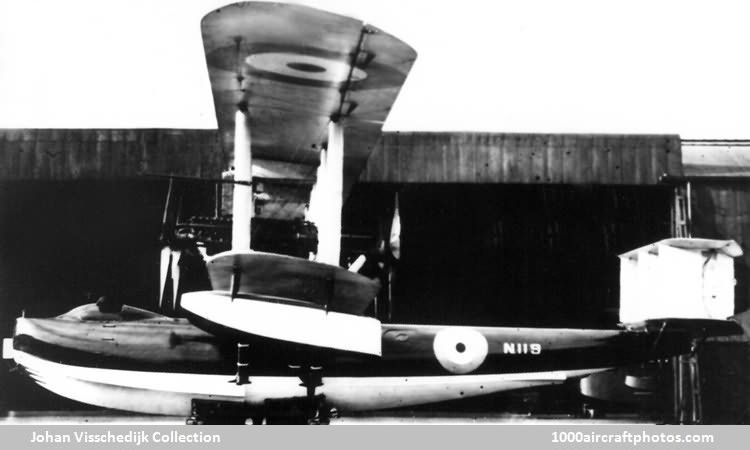08/31/2010. Remarks by Johan Visschedijk: "This very large four-engined reconnaissance aircraft was designed by The Fairey Aviation Co. Ltd. of Hayes, Middlesex to meet the Admiralty requirement N.4. The biplane was fitted with fabric covered three-bay wings of unequal span, with ailerons on all four wings. The two-step hull was of wooden construction with stressed skin, and the tail unit consisted of a biplane tail plane fitted with three fins and rudders.
The forward gunner and pilots sat in twin open cockpits in the nose, while the beam gunners sat in two oval apertures aft of wing. Armament consisted of 0.303 in (7.7 mm) Lewis guns at gunners positions, and a 1,000 lb (454 kg) bomb load. The responsibility for the hull construction and erection of the N.4 machines is described inconsistently in various sources. The information presented here is from British Built Aircraft Volume 2 and 5, by Ron Smith, and is believed to correctly represent an undeniably complex saga:
N.4 Mk.I Atalanta, serial N118 c/n F.275 used a hull designed by Charles Nicholson and built by the Gosport Aircraft Co. Ltd. of Gosport, Hampshire. This aircraft had its wing structure added by the Phoenix Dynamo Manufacturing Co. Ltd at Bradford, West Yorkshire, before being moved by road to the Isle of Grain, Kent. It was used for flotation tests but was never fully completed and remained unflown.
N.4 Mk.I Atalanta, serial N119. The hull for this aircraft was built by the May Harden & May Ltd. of Hythe, Hampshire and was sent by road to Dick, Kerr & Co. at Lytham St. Annes, Lancashire by a circuitous route to meet up with its superstructure. Power plants fitted were four 650 hp Rolls-Royce Condor IA twelve-cylinder liquid-cooled V-engines arranged in tractor and pusher pairs mounted between the wings. Completed in 1921, this aircraft was taken by road to the Isle of Grain for test flying. However, it was stored and the world's largest flying boat was not flown until July 4, 1923.
The N.4 Mk.II Titania, serial N129 c/n F.337, had a hull of Linton Hope design. The Titania hull was constructed on the Clyde at the yard of the yacht-builders Fyffes, being delivered (again by road) to The Fairey Aviation Co. Ltd at Hamble, Southampton for completion. The wing superstructure was manufactured in Hayes and sent 'piecemeal' to Hamble for erection. Eventually, another road journey took Titania to the Isle of Grain, where it was flown on July 24, 1925, powered by four 650 hp Rolls-Royce Condor III engines."
